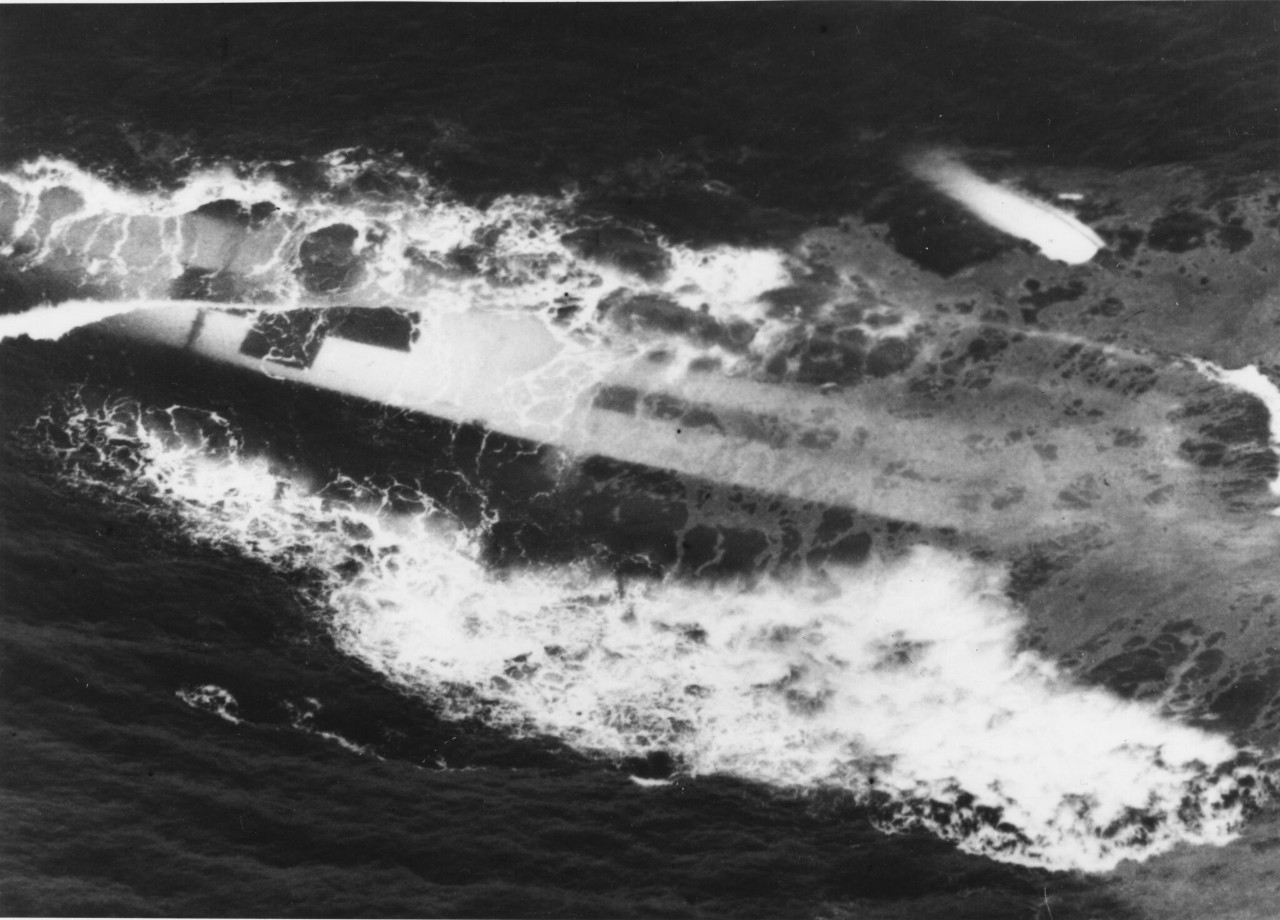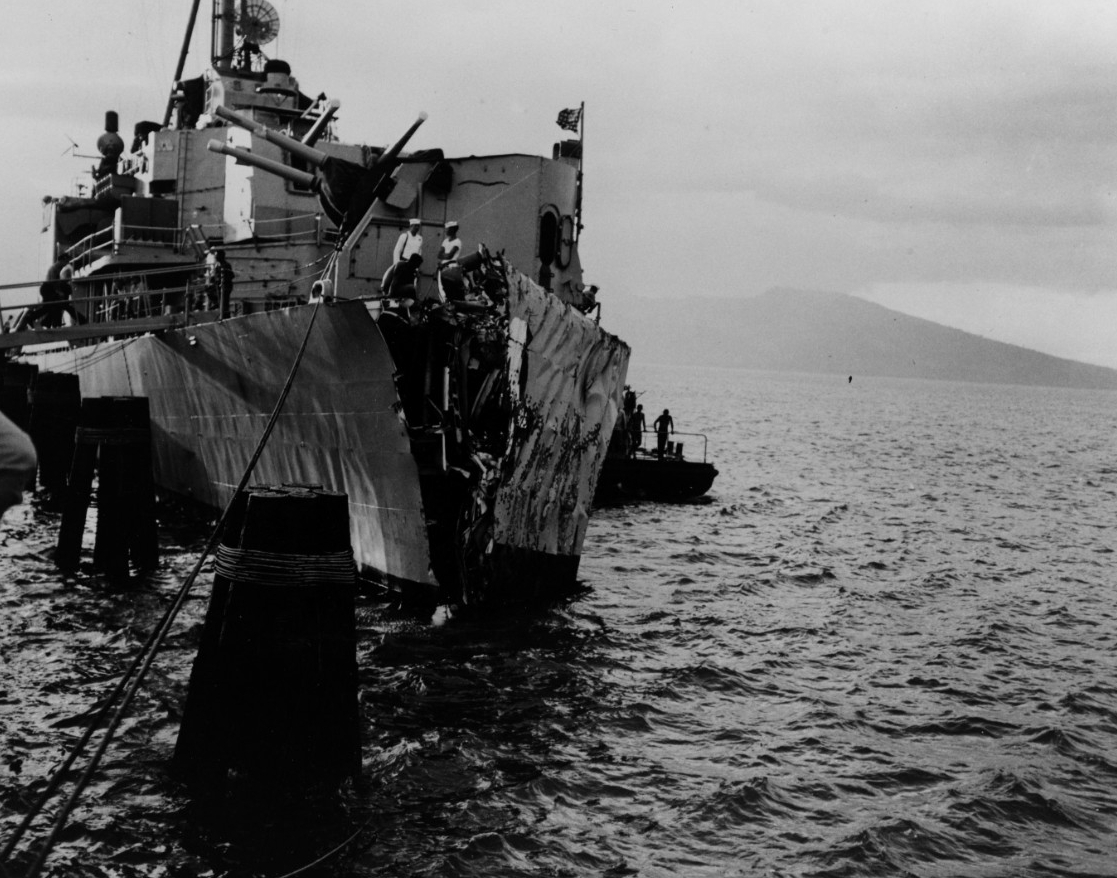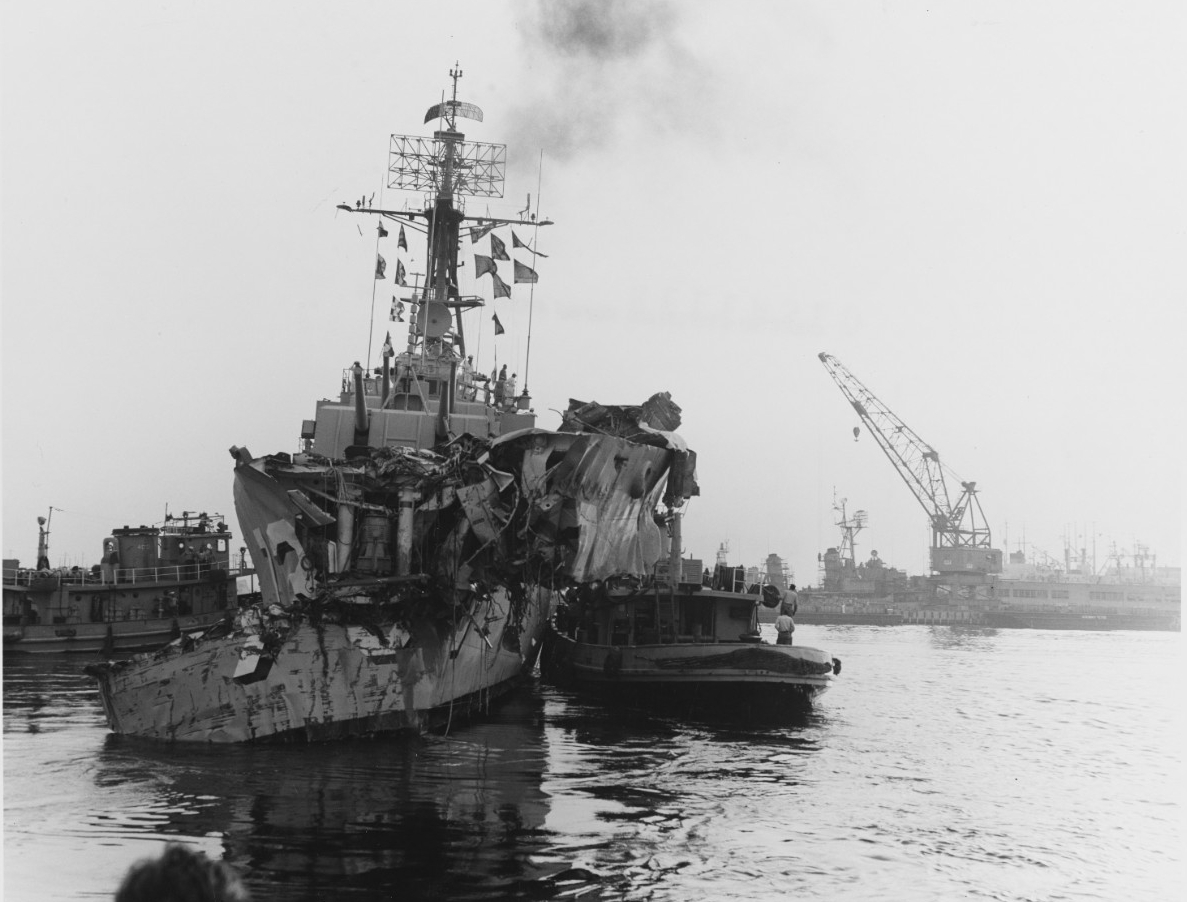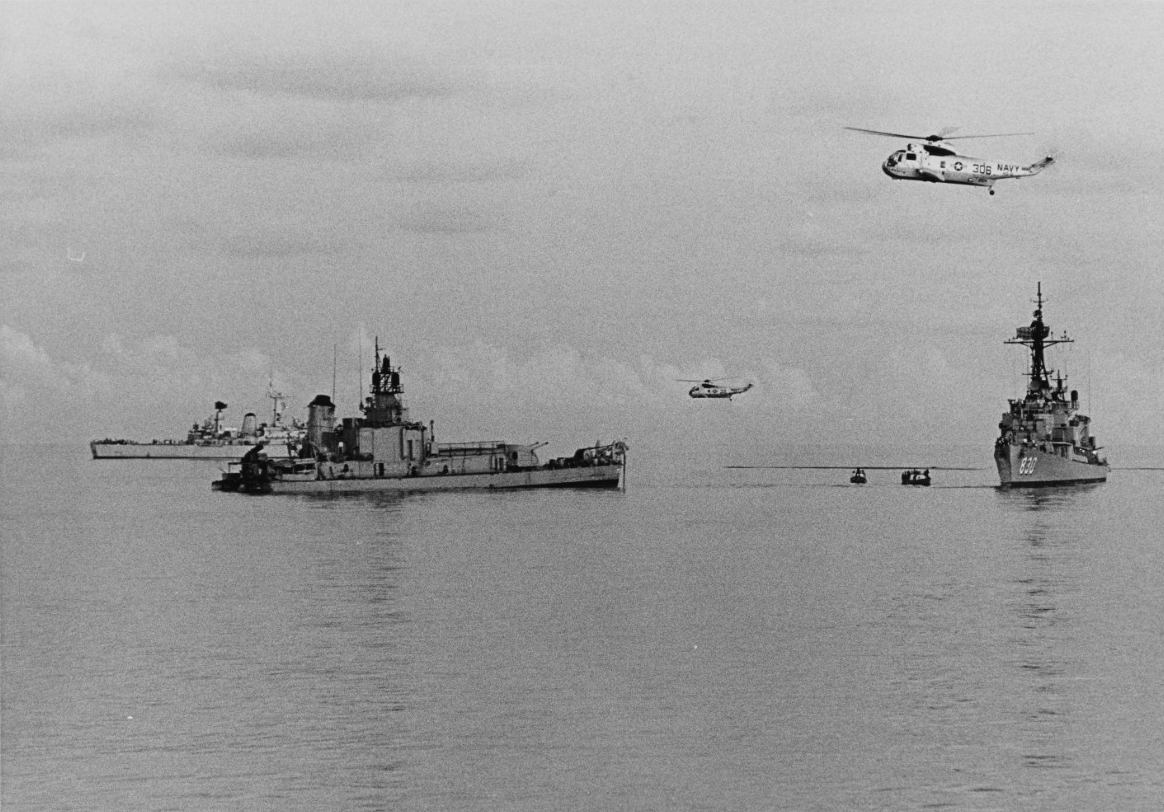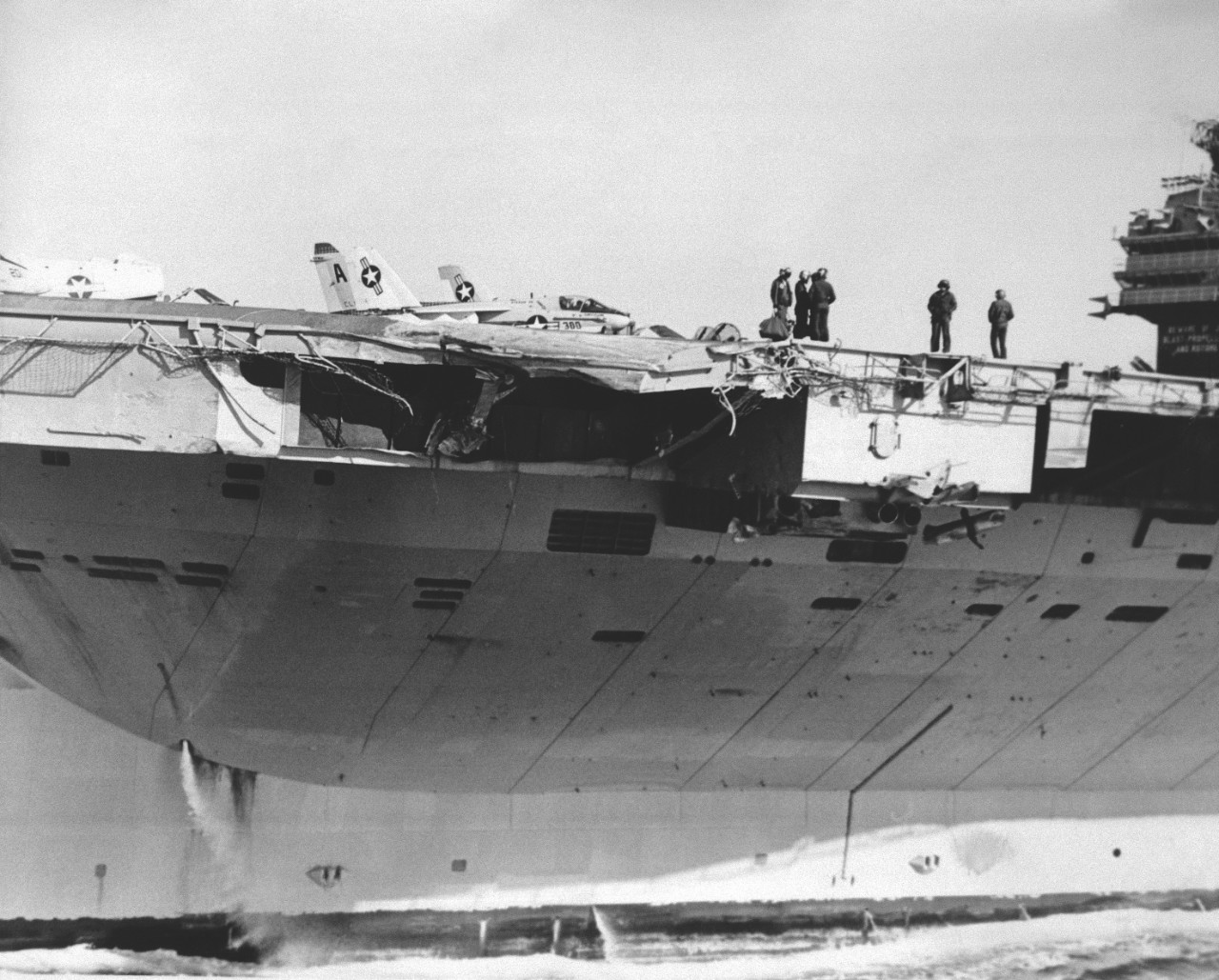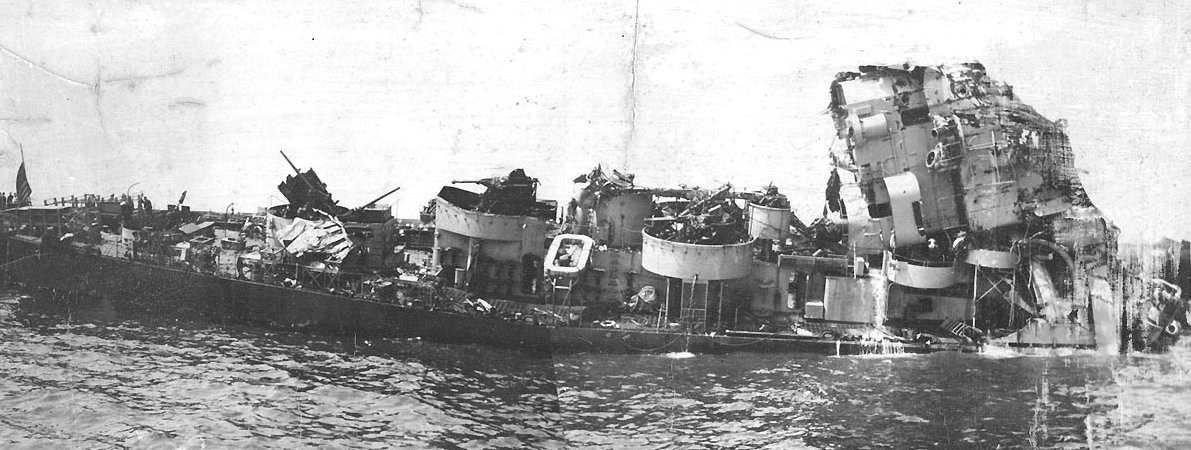H-071-2: U.S. Navy Surface Ship Accidents Since World War II Resulting in Fatalities or Loss of Ship
Note: This list does not include single-man overboards, nor does it include numerous accidents aboard aircraft carriers. The moral of this story is that despite recent accidents, the Navy’s current safety record is vastly better than it used to be.
Collisions
25 August 1950—Benevolence (AH-13)
After being brought out of reserve status due to the Korean War, while returning to San Francisco from a trial run in a dense fog, hospital ship Benevolence was struck by the merchant ship Mary Luckenbach. Benevolence sank within 20 minutes, about 4 miles off the Golden Gate Bridge, with 23 dead (505 aboard were rescued).
14 May 1951—Valcour (AVP-55)
While passing the collier SS Thomas Tracy off Cape Henry, Virginia, seaplane tender Valcour suffered a power failure and steering casualty, veering into the path of the collier, which rammed Valcour’s starboard side. Due to a ruptured aviation fuel tank, an intense fire broke out on Valcour, forcing many crew members to leap overboard. In addition to the raging fire, Valcour was taking on water and the commanding officer ordered abandon ship. Submarine rescue ship Sunbird (ASR-15) and U.S. Coast Guard tugboat Cherokee were subsequently able to bring the fire under control and save the ship, but 36 men were lost and 16 injured.
26 April 1952—Hobson (DMS-26)
See H-071-1.
11 March 1956—Columbus (CA-74) and Floyd B. Parks (DD-884)
Destroyer Floyd B. Parks collided with heavy cruiser Columbus off Luzon, Philippines. Floyd B. Parks lost 40 feet of her bow and two crew members. Good damage control saved the ship, and she went into Subic Bay under her own power for temporary repairs. Upon her return to Long Beach Naval Shipyard in May 1956, her damaged bow was replaced by that of Lansdale (an uncompleted destroyer). Floyd B. Parks went on to serve in the Vietnam War. Damage to Columbus was minimal.
5 March 1959—Kenneth D. Bailey (DD-713)
The Military Sea Transportation Service supply ship Haiti Victory collided with destroyer Kenneth D. Bailey in the Strait of Gibraltar. One crew member on the destroyer was killed and 24 injured, four seriously. Kenneth D. Bailey was repaired and made multiple Mediterranean deployments until she was sold to Iran for spare parts in 1975.
19 March 1960—Darby (DE-218)
While serving as a reserve training vessel, destroyer escort Darby collided with ore carrier SS Soya Atlantic while entering Chesapeake Bay en route to Little Creek, with two crew members killed and one seriously injured. The subsequent Coast Guard board of investigation determined the commanding officer and officer of the deck of Darby were responsible for the collision.
10 July 1960—Ammen (DD-527) and Collet (DD-730)
Destroyer Collet collided with destroyer Ammen in dense fog off Newport Beach, California. The accident occurred while Ammen was in transit from Seal Beach to San Diego to be decommissioned, killing 11 crew members and injuring 20 aboard Ammen. Ammen suffered extensive damage to the after deck house and below the waterline, but the crew controlled the flooding. Ammen was first towed to Long Beach and then to San Diego to complete decommissioning. Collet suffered a badly smashed bow, pretty much everything forward of the forward 5-inch gun mount, but suffered no deaths or serious injury.
Collet reached Long Beach under her own power. Upon reaching Long Beach Naval Shipyard, her bow was replaced by that of Seaman, an incomplete destroyer in the reserve fleet. Collet subsequently earned two battle stars in the Vietnam War before being sold to Argentina in 1974. As Ara Piedra Bueno, she was in company with light cruiser Ara General Belgrano (ex-Phoenix) when Belgrano was torpedoed and sunk by British submarine HMS Conqueror in the Falklands War.
27 August 1965—Newman K. Perry (DD-883) and Shangri-La (CVA-38)
While conducting exercises in the Tyrrhenian Sea, destroyer Newman K. Perry accidentally rammed carrier Shangri-La, holing the carrier below the waterline, which was quickly patched. The destroyer’s bow was badly smashed forward of the No. 1 5-inch gun mount, with one crew member trapped in a crushed compartment, who subsequently died after extensive efforts to cut him free. Two other destroyer crew members were injured. Newman K. Perry was repaired and subsequently served in combat operations in Vietnam.
2 February 1967—McMorris (DE-1036)
During a night antisubmarine warfare exercise off Hawaii, gasoline tanker Tombigbee (AOG-11) rammed destroyer escort McMorris, penetrating to within a few feet of the keel, shearing off the step masthead and destroying four compartments on the main deck. Two crew members on McMorris were killed and seven injured. All communications and propulsion was lost. McMorris was towed to Pearl Harbor Naval Shipyard and repaired.
3 June 1969—Frank E. Evans (DD-754)
At about 0300, destroyer Frank E. Evans was operating in a multinational formation of British, Australian, and New Zealand ships, centered on Australian aircraft carrier HMAS Melbourne in the South China Sea. As Melbourne was going to flight quarters, Frank E. Evans, on Melbourne’s port side, was ordered to take up plane guard position on Melbourne’s port quarter. As a result of confusion on the bridge of Frank E. Evans, the destroyer turned to starboard across Melbourne’s bow. Both ships took evasive action which however only resulted in placing the destroyer ahead of Melbourne again. The destroyer was then struck amidships and cut completely in two. The forward half of the destroyer sank in less than five minutes along with 73 of her crew. The aft half of the destroyer remained afloat, scraping along the starboard side of Melbourne until the Australians could secure the section alongside, allowing the destroyer’s crew to cross over. About 60 to 100 crew members were rescued from the water, including some by Melbourne’s crew. One body was recovered, for a total of 74 killed of Frank E. Evans’s 273 crew members. The stern section was towed to Subic Bay and later sunk as a target.
The joint U.S.–Australian board of inquiry proved to be quite contentious and would mark a low point in U.S. Navy–Royal Australian Navy relations due to U.S. efforts to place at least part of the blame on Melbourne while U.S. Navy officers conceded privately that Evans was wholly at fault. The commanding officer of Melbourne was acquitted at courts-martial. The two junior officers on the bridge of Evans at the time pleaded guilty to charges of dereliction of duty and negligence. The commanding officer of Evans, who was asleep at the time, pleaded not guilty, but was found guilty of dereliction of duty and negligently hazarding his ship. The training film, I Relieve You, Sir (probably seen by all of us) was based on this collision.
Although Frank E. Evans had been operating in the Vietnam War zone prior to the collision and was scheduled to return to Vietnam upon conclusion of the multinational exercise, the collision took place just outside the designated zone, and the exercise was not deemed directly related to Vietnam operations. As a result, the lost crew members were deemed ineligible for inclusion on the Vietnam Memorial Wall. Several attempts to rectify this have been unsuccessful (and it is actually quite complicated for a number of reasons, one of which is no room on the memorial).
22 November 1975—Belknap (CG-26) and John F. Kennedy (CV-67)
At night in heavy seas off the coast of Sicily, confusion on the bridge of guided-missile cruiser Belknap resulted in a collision between Belknap and carrier John F. Kennedy. As Belknap scraped along Kennedy’s port side, ruptured JP-5 lines on Kennedy poured fuel onto Belknap, resulting in a fire on both ships. The fire on Kennedy was extinguished, with one squadron sailor killed by smoke inhalation. The fire on Belknap took hours to extinguish, complicated by Belknap’s aluminum superstructure. Most of the seven crew members killed on Belknap were trapped in engineering spaces below. Guided-missile destroyer Claude V. Ricketts (DDG-5) and destroyer Bordelon (DD-881) came alongside Belknap to assist in fighting the fire and were showered by debris when Belknap’s 3-inch ready ammunition locker cooked off. The frigate Pharris (FF-1094) assisted in fighting the fire on Kennedy. Belknap’s superstructure burned almost completely to the main deck. In addition to the seven dead, 47 Belknap crew members were injured. Belknap was subsequently almost completely rebuilt, serving as the Sixth Fleet flagship in the late 1980s. Bordelon later collided with Kennedy while refueling on 22 November 1975; Although there were no fatalities, damage to Bordelon was severe enough that she was not repaired or returned to service.
28 August 1976—Voge (FF-1047)
Frigate Voge was tracking K-22, a Soviet Echo II-class nuclear guided-missile submarine, southwest of Crete when K-22 rammed Voge at 17 knots in the port quarter. The collision caused significant structural damage to the stern of Voge. The frigate was towed to Souda Bay, then to dry dock in Toulon, France, for repairs. The Soviet submarine was badly damaged but received emergency repairs at the Soviet Kithira anchorage. There were no fatalities (just an interesting event).
21 August 2017—John S. McCain (DDG-56)
Encountering steering control problems near the Strait of Malacca, McCain crossed ahead and was struck by Liberian-flagged tanker Alnic MC before dawn. Ten crew members on McCain died in a flooded berthing compartment. McCain was transported from Singapore via heavy-lift transport ship MV Treasure. After repairs were completed at Fleet Activities Yokosuka in October 2019, McCain returned to service.
Explosions/Fires
30 April 1946—Solar (DE-221)
The destroyer escort Solar was destroyed in an ordnance accident and explosion at Naval Ammunition Depot, Earle, New Jersey, with seven killed and 30 injured.
7 October 1949—Chehalis (AOG-48)
Gasoline tanker Chehalis was sunk by fire and explosion at Tutuila, Samoa, suffering six killed.
21 April 1952—Saint Paul (CA-73)
During gunfire operations off North Korea, a powder blast in the forward turret of heavy cruiser Saint Paul killed 30 crew members.
18 July 1957—Somersworth (PCER-849)
An explosion aboard patrol ship Somersworth off Montauk Point, New York, killed three crew members and injured four.
12 August 1960—Exultant (MSO-441)
A flash fire in the engineering spaces of minesweeper Exultant off Savannah, Georgia, killed five crew members.
22 June 1967—Raleigh (LPD-1)
An engine room steam accident on amphibious transport dock Raleigh killed two crew members.
7 September 1968—Douglas H. Fox (DD-779)
While operating off Charleston, South Carolina, a fire aboard destroyer Douglas H. Fox killed two crew members and injured six.
28 June 1971—Trenton (LPD-14)
An engine room main guarding steam valve ruptured on amphibious transport dock Trenton, instantly killing four sailors and burning six others, two of whom later died.
1 October 1972—Newport News (CA-148)
While operating off Vietnam, a turret fire and explosion on heavy cruiser Newport News killed 20 crew members and injured 36 more.
30 October 1972—Florikan (ASR-9)
A fire in the forward hold of submarine rescue ship Florikan resulted in the death of one crew member.
3 February 1973—Basilone (DD-824)
While conducting underway training and a burial at sea off the Virginia Capes, a boiler explosion in the after fireroom of destroyer Basilone killed seven sailors and injured four more. (An event I was very aware of while in the engineering spaces of Basilone on my 1977 midshipman 3/C cruise in the Mediterranean).
9 April 1979—Manley (DD-940)
A fuel line rupture and fire on destroyer Manley resulted in one officer dying from burns and eight sailors suffering minor burns.
19 April 1989—Iowa (BB-61)
While conducting firing practice northeast of Puerto Rico, an explosion in the No. 2 16-inch gun turret of battleship Iowa killed 47 and injured 11. For more detail see H-Gram 029-4.
9 May 1989—White Plains (AFS-4)
While operating 100 miles east of Hong Kong, a fire in the engine room of combat stores ship White Plains killed six crew members.
8 May 1990—Conyngham (DDG-17)
A severe fuel fire in the forward boiler room of guided-missile destroyer Conyngham burned for 23 hours, killing one officer and injuring 18 sailors. The damage was bad enough that the ship was decommissioned and sold for scrap.
30 October 1990—Iwo Jima (LPH-2)
While taking part in amphibious landing exercises in the Arabian Sea in preparation for Operation Desert Storm, a steam valve ruptured on amphibious assault ship Iwo Jima, killing 10 crew members.
22 February 1992—Dahlgren (DDG-43)
An engine room fire on guided-missile destroyer Dahlgren killed two crew members and injured four others.
19 October 2001—Inchon (MCS-12)
A boiler room oil fire on mine countermeasures ship Inchon killed one sailor and injured seven others. The sailor who died, Petty Officer Third Class Ronnie Palm was awarded a posthumous Navy and Marine Corps Medal for helping fellow sailors escape.
12 July 2020—Bonhomme Richard (LHD-6)
A fire was started by arson on the lower vehicle deck of amphibious assault ship Bonhomme Richard while she was undergoing major maintenance. The fire took four days to extinguish and injured at least 63 sailors and civilian firefighters. Repairs were estimated to cost up to $3.2 billion and take seven years, so the ship was decommissioned and sold for scrap (making this the most expensive peacetime disaster in U.S. Navy history).
Liberty Boat Accidents
16 February 1948
A liberty boat capsized in the Mediterranean off Les Salines de Hyeres, drowning eight sailors.
2 June 1948
A Navy launch approaching an aircraft carrier sank off Norfolk, Virginia, with the loss of 31 personnel.
24 May 1951
A liberty launch capsized off Newport, Rhode Island, drowning 19 personnel.
21 January 1954
A landing craft sank after a collision in Inchon harbor, drowning 24 Marines.
17 January 1977
A landing craft, mechanized (LCM-6) from Trenton capsized after colliding with Spanish merchant ship Urlea, off Barcelona, Spain, while carrying sailors and Marines returning from liberty to Trenton and Guam (LPH-9), killing 49 personnel.
21 December 1990
An Israeli-chartered ferry, shuttling crew members of carrier Saratoga (CV-60), capsized and sank in 20 seconds off Haifa, Israel, drowning 21 personnel.
Other Accidents
4 February 1960—Daly (DD-519)
During a storm off Virginia, destroyer Daly took a 65 degree roll from a rogue wave. One sailor was killed aboard ship and five others were lost overboard.
7 February 1968—Bache (DD-470)
Destroyer Bache was grounded at Rhodes, Greece, by heavy winds and seas. The ship was abandoned. Although there were no serious injuries, the ship was later broken up in place for salvage.
9 February 1980—King (DDG-41)
During a severe storm off Cape Hatteras, four sailors were swept overboard from guided-missile destroyer King. Only one was rescued and the other three drowned.
12 September 2000—La Moure County (LST-1194)
During a routine training evolution off Chile, near Caleta Cifuncho Bay, landing ship tank La Moure County ran hard aground. Although there were no fatalities or injuries, the ship was damaged beyond repair. She was eventually towed off by a Chilean icebreaker and sunk as a target in the multinational maritime exercise UNITAS 2001.
18 November 2001—Peterson (DD-969)
The decrepit tanker Samra had been detained for smuggling Iraqi oil in violation of UN sanctions. During heavy weather in the Persian Gulf, the Samra foundered, taking two sailors of destroyer Peterson’s boarding team down with it.
14 May 2002— Essex (LHD-2)
During the first day of exercise Cobra Gold in Thailand a landing craft, air cushion (LCAC) hovercraft off Essex struck and killed a U.S. sailor from Beach Master Unit One, Detachment Western Pacific, Sasebo, Japan.
17 January 2013—Guardian (MCM-5)
Mine countermeasures ship Guardian ran hard aground on Tubbataha Reef in the Sulu Sea, Philippines. There were no casualties, but the ship could not be recovered and was dismantled in place. The U.S. government paid the Philippine government $1.9 million for damage to the protected reef. Although the reef was mischarted, the investigation revealed the ship’s crew did not adhere to standard US Navy navigation procedures.

